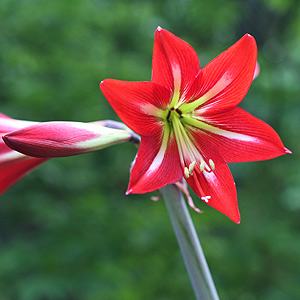
Also known as the St. Joseph’s Lily, Hippeastrum x johnsonii is one of the easiest of the Amarylis to grow.
Its natural flowering cycle would have it as a spring flowering bulb, however along with many other varieties it is grown indoors and is widely seen at Christmas time where the brilliant flowers add color.
This is one of the very first hybrid hippeastrums, bred in the UK in the early 1800s and believed to be a Hippeastrum reginae x Hippeastrum vitattum type hybrid.
Care
Outdoors Hippeastrum x johnsonii is best in a well drained soil with a cool winter.
Indoors it is widely grown in containers.
Always store bulbs so that the roots do not dry out. The roots of bulbs can be soaked overnight to rehydrate them a little before planting.
These are a bulb that needs to be planted with 1/3 to 1/2 above the ground. This helps prevent rot.
In containers us a pot with around 1 – 2 inches of space around the bulb. Remember that these are a tall growing plant and can get a little top heavy. Larger heavier pots reduce the risk of them falling over when in full flower.
When first planted bulbs need only a little water, the roots will develop and then new growth will appear. This is when watering is increased.
In brief, Hippeastrum like
- Humus rich well drained soil
- Dry winters
- To be planted with the neck of the bulb above soil level.
Buying Hippeastrum x johnsonii
When buying these bulbs look for larger ones, they are more likely to flower the first year and may put up multiple flower stalks. Also look for bulbs with good fleshy root systems attached, again you will get better results than from those with no roots or dried out root systems.
Avoid bulbs that are soft or show signs of disease.
Planting Hippeastrum x johnsonii
The neck of the bulb need to be above soil level to prevent rot.
Water when first planting, however keep fairly dry through winter.
Fertilize when in active growth with a liquid seaweed fertilizer.
Leave foliage to die back naturally.
Other Hippeastrums
Remember that we have been calling these plant Amarylis for a number of years.
A few species such as Hippeastrum papilio, with wonderful green and deep red flowers are well worth seeking. If you could grow it, H. blossfeldiae is attractive, orange to red flowers with a green center. H. cybister with its spidery flowers is rare but fascinating.
The recently discovered, H. mandonii, lime green flowers with scarlet red tips is rarely offered.

